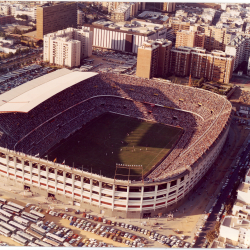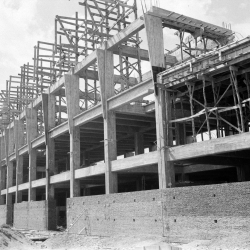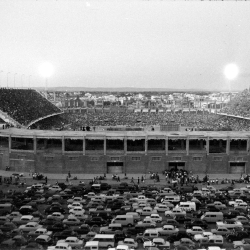


After 30 years, Viejo Nervión was starting to become too small and outdated. The new demands of football required comforts and capacities that the old stadium could not satisfy. That is why the Ramón Sánchez-Pizjuán Stadium was inaugurated on 7th September 1958, in a match against Real Jaén that ended in a three-goal draw. The new stadium was located next to the grounds of the old one.
The idea of building the new stadium was first mooted in November 1937, when Ramón Sánchez-Pizjuán negotiated with Pablo Armero the purchase of the Nervión stadium and an annex of 42,000 square metres, where the new stadium was to be built.
The project for this new stadium dates back to 1954. In January of that year, Sevilla FC organised a competition for ideas for the construction of a new stadium with a capacity of at least 50,000 spectators.
The competition was won by the architect Manuel Muñoz Monasterio, who had years earlier built the Santiago Bernabéu and Mestalla, and who was about to begin construction of the Ramón de Carranza in Cádiz. Thus, the architect from Madrid obtained the prize of 50,000 pesetas, the amount that the winning sketch was endowed with, and also received the commission for the final project.
The approved project consisted of a stadium with a capacity for 70,329 spectators, 20,329 seated and 50,000 standing, with the standing areas behind both goals and also in the upper tier of the Fondo Stand.
The sudden death of President Sánchez-Pizjuán, on 28 October 1956, prevented him from seeing his lifelong dream come true, but the Presidents who succeeded him, especially Ramón de Carranza and Gómez-Pablos, Marquis of Soto Hermoso, who promised over Sánchez-Pizjuán's dead body that his dream would come true, would take charge of the definitive construction of the stadium. On 2 December of the same year, 36 days after the death of the distinguished president, the first stone of the new stadium was laid. The stadium was built in a record time of 22 months and 6 days. The Ramón Sánchez-Pizjuán Stadium was inaugurated and opened to the public, without the upper tiers behind the goals and with the upper tier of the Main Stand only half finished. During that same season, the Main Stand was completed, but the stands behind the goals had to wait until 1975. In September 1959, a friendly match was played against Bayern Munich, an event that served to inaugurate the floodlights. The first electric lighting consisted of four towers installed in the corners of the stadium, the installation was entrusted to the company Abengoa and had a power of 250 LUX, which was almost double that of the best stadiums in Europe at the time.
The work was initially to be carried out by the company Agromán, but finally the proposal was accepted from the Catalan company Ingar, which had carried out the construction of FC Barcelona's Camp Nou and which offered the cheapest work and the best payment conditions. To cover the cost of the work, estimated at 50 million pesetas, 100,000 bonds were issued at a price of 500 pesetas. They were issued in equal shares by the Banco Español de Crédito and the Caja Provincial de Sevilla.
Between the latter months of 1974 and the start of 1975, the stadium was finally completed. The cost of the work amounted to 78 million pesetas. To pay for this amount, numerous "Row 0" tickets and symbolic tickets costing 50 and 100 pesetas were sold. The financial support of Gabriel Rojas was vital for the completion of this work. On 7th September 1975, the upper tier of Gol Sur was inaugurated in a match against Las Palmas, while on 26th October 1975, the upper tier of Gol Norte was inaugurated in a match against Valencia CF.
In 1982, due to legal provisions, its capacity was reduced to 66,000 spectators, and a large part of the stadium was remodelled to host a semi-final of the 1982 World Cup, specifically the France-Germany match. The fences installed in the 1970s were removed and a moat was built around the pitch. The Main Stand roof was built and the artist Santiago del Campo built a majestic monumental mosaic on the façade of the Main Stand. The cost of these works amounted to 400 million pesetas.
In 1986, on 21st April, the European Cup final between FC Barcelona and the Romanian team Steaua Bucharest took place.
In 1996, UEFA decreed that all stadiums must be all-seater. As a result, the capacity of the Ramón Sánchez-Pizjuán was considerably reduced to 42,714.
In 2015, a new comprehensive refurbishment work began. Among other interventions, the following are included: replacement of the colour of the seats, most of which are now red; covering of the outer façade with a metallic skin with LED lighting; renovation of all the stadium bars and toilets; installation of two new video scoreboards; replacement of the separation fences between stands with glass, etc.The refurbishment work is currently continuing.
In 2022, on 18th May, the stadium hosted the UEFA Europa League final between Glasgow Rangers FC and Eintracht Frankfurt. In this way, the Ramón Sánchez-Pizjuán became one of only six major European stadiums to host the single-leg final of the two main UEFA club competitions.
Finally, it should be added that the Spanish national team has not lost a single match at the Ramón Sánchez-Pizjuán Stadium, from the first match played in 1961 to the last one in 2015. In total there have been 25 matches, with a record of 20 wins and 5 draws, and the stadium has been formally designated as Player Number 12 by the RFEF.



 Spanish
Spanish
 English
English
 عربي
عربي
 中文
中文
 日本語
日本語